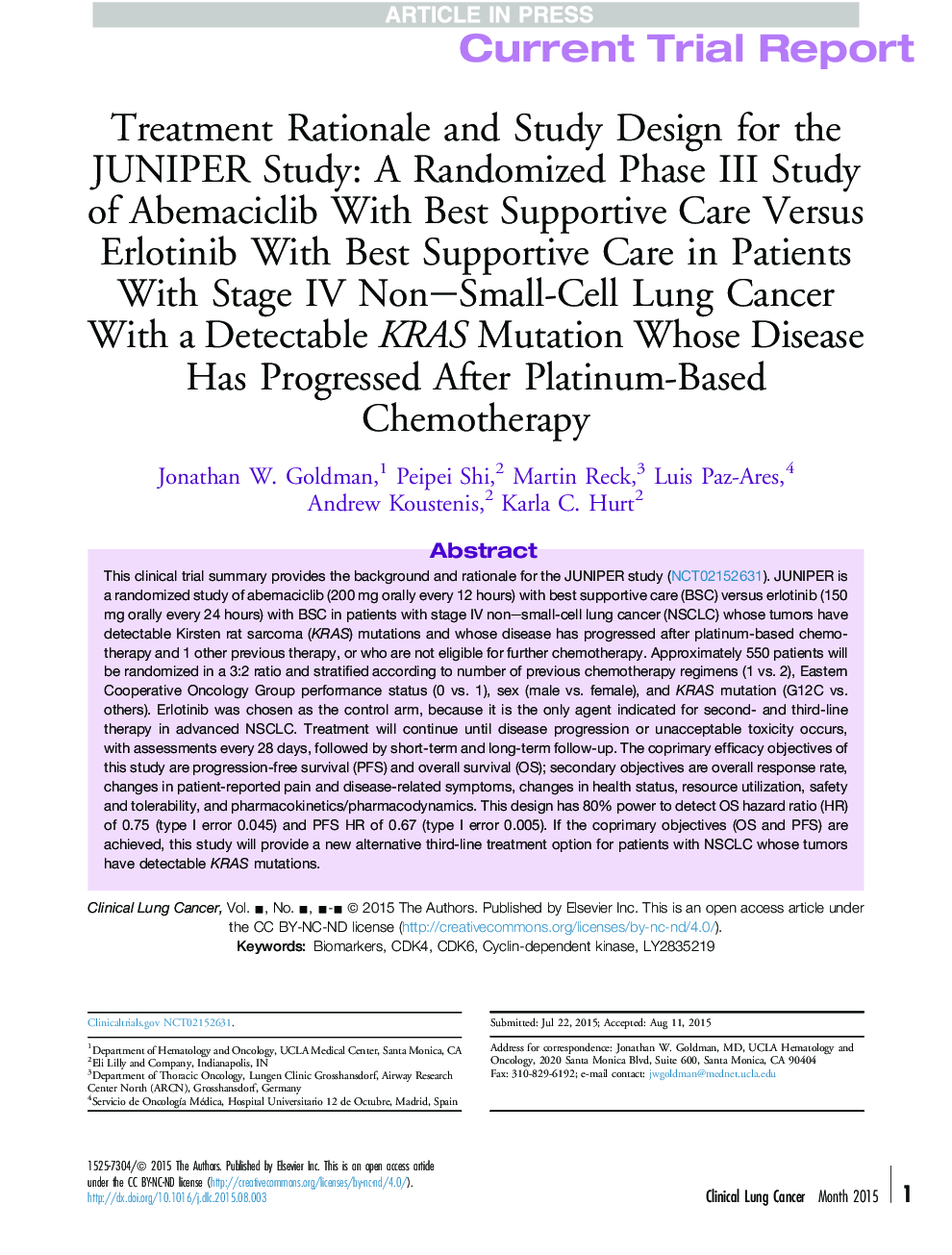| کد مقاله | کد نشریه | سال انتشار | مقاله انگلیسی | نسخه تمام متن |
|---|---|---|---|---|
| 5882711 | 1149587 | 2016 | 5 صفحه PDF | دانلود رایگان |
عنوان انگلیسی مقاله ISI
Treatment Rationale and Study Design for the JUNIPER Study: A Randomized Phase III Study of Abemaciclib With Best Supportive Care Versus Erlotinib With Best Supportive Care in Patients With Stage IV Non-Small-Cell Lung Cancer With a Detectable KRAS Mutati
دانلود مقاله + سفارش ترجمه
دانلود مقاله ISI انگلیسی
رایگان برای ایرانیان
کلمات کلیدی
موضوعات مرتبط
علوم پزشکی و سلامت
پزشکی و دندانپزشکی
بیهوشی و پزشکی درد
پیش نمایش صفحه اول مقاله

چکیده انگلیسی
This clinical trial summary provides the background and rationale for the JUNIPER study (NCT02152631). JUNIPER is a randomized study of abemaciclib (200 mg orally every 12 hours) with best supportive care (BSC) versus erlotinib (150 mg orally every 24 hours) with BSC in patients with stage IV non-small-cell lung cancer (NSCLC) whose tumors have detectable Kirsten rat sarcoma (KRAS) mutations and whose disease has progressed after platinum-based chemotherapy and 1 other previous therapy, or who are not eligible for further chemotherapy. Approximately 550 patients will be randomized in a 3:2 ratio and stratified according to number of previous chemotherapy regimens (1 vs. 2), Eastern Cooperative Oncology Group performance status (0 vs. 1), sex (male vs. female), and KRAS mutation (G12C vs. others). Erlotinib was chosen as the control arm, because it is the only agent indicated for second- and third-line therapy in advanced NSCLC. Treatment will continue until disease progression or unacceptable toxicity occurs, with assessments every 28 days, followed by short-term and long-term follow-up. The coprimary efficacy objectives of this study are progression-free survival (PFS) and overall survival (OS); secondary objectives are overall response rate, changes in patient-reported pain and disease-related symptoms, changes in health status, resource utilization, safety and tolerability, and pharmacokinetics/pharmacodynamics. This design has 80% power to detect OS hazard ratio (HR) of 0.75 (type I error 0.045) and PFS HR of 0.67 (type I error 0.005). If the coprimary objectives (OS and PFS) are achieved, this study will provide a new alternative third-line treatment option for patients with NSCLC whose tumors have detectable KRAS mutations.
ناشر
Database: Elsevier - ScienceDirect (ساینس دایرکت)
Journal: Clinical Lung Cancer - Volume 17, Issue 1, January 2016, Pages 80-84
Journal: Clinical Lung Cancer - Volume 17, Issue 1, January 2016, Pages 80-84
نویسندگان
Jonathan W. Goldman, Peipei Shi, Martin Reck, Luis Paz-Ares, Andrew Koustenis, Karla C. Hurt,